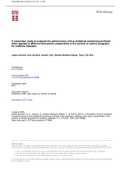Summary
Summary A simulation study to evaluate the performance of five statistical monitoring methods when applied to different time-series components in the context of control programs for endemic diseases
- Course
- Institution
- Book
A simulation study to evaluate the performance of five statistical monitoring methods when applied to different time-series components in the context of control programs for endemic diseases
[Show more]



